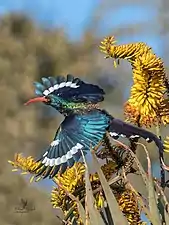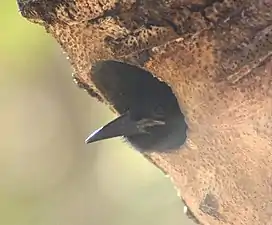| Green wood-hoopoe | |
|---|---|
.jpg.webp) Green wood hoopoe at Mapungubwe National Park, Limpopo, South Africa | |
| Chattering calls of P. p. niloticus in the Mtembur area of western Kenya | |
| Scientific classification | |
| Domain: | Eukaryota |
| Kingdom: | Animalia |
| Phylum: | Chordata |
| Class: | Aves |
| Order: | Bucerotiformes |
| Family: | Phoeniculidae |
| Genus: | Phoeniculus |
| Species: | P. purpureus |
| Binomial name | |
| Phoeniculus purpureus (J.F. Miller, 1784) | |
The green wood hoopoe (Phoeniculus purpureus) is a large, up to 44 cm (17 in) long tropical bird native to Africa. It is a member of the family Phoeniculidae, the wood hoopoes, and was formerly known as the red-billed wood hoopoe.
Taxonomy
In 1784 the English illustrator John Frederick Miller included a hand-coloured plate of the green wood hoopoe in his Icones animalium et plantarum. He coined the binomial name Promerops purpureus and mistakenly specified the type locality as eastern India.[2] The green wood hoopoe is now one of five species placed in the genus Phoeniculus that was introduced in 1821 by the Polish zoologist Feliks Paweł Jarocki.[3]
Six subspecies are recognised:[3]
- P. p. senegalensis (Vieillot, 1822) – south Senegal to south Ghana
- P. p. guineensis (Reichenow, 1902) – north Senegal and Gambia to Chad and Central African Republic
- P. p. niloticus (Neumann, 1903) – Sudan to west Ethiopia and northeast DR Congo
- P. p. marwitzi (Reichenow, 1906) – east Uganda and Kenya to east South Africa
- P. p. angolensis (Reichenow, 1902) – Angola and west Zambia to northeast Namibia and north Botswana
- P. p. purpureus (Miller, JF, 1784) – central, southwest South Africa
The green wood hoopoe is sometimes considered as conspecific with the black-billed wood hoopoe (Phoeniculus somaliensis) and the violet wood hoopoe (Phoeniculus damarensis).[4][5][6]
Description
This abundant species is a metallic dark green, with a purple back and very long diamond-shaped purple tail. Distinctive white markings on the wings and white chevrons on the tail edges make it easily identifiable, as does its long, thin, curved red bill. Sexes are similar, but immatures have a black bill.
It advertises its presence with its loud kuk-uk-uk-uk-uk call and other vocalisations.
Behaviour and ecology
Food and foraging
The green wood hoopoe is an insect-eating species. It feeds mainly on the ground, at termite mounds, or on tree trunks, and forms flocks outside the breeding season. Its specialised claws enable it to cling easily to the underside of branches while closely inspecting the bark for insects.
Breeding
The green wood hoopoe is a cooperative breeder and common resident in the forests, woodlands and suburban gardens of most of sub-Saharan Africa. It is found in groups of up to a dozen or so birds with only one breeding pair. The breeding female lays two to four blue eggs in a natural tree hole or old barbet nest and incubates them for about 18 days. On hatching, she and the nestlings are fed by the rest of the group, even after they have fledged and left the nest hole. The group is fearless in defence of the nestlings against intruders. This species is parasitised by the greater and lesser honeyguide.[7]
Status
Widespread and common throughout its large range, the green wood hoopoe is assessed as Least Concern on the IUCN Red List of Threatened Species.
Gallery
.jpg.webp) Chattering family group
Chattering family group_-_Flickr_-_Lip_Kee_(5).jpg.webp) Chattering and displaying
Chattering and displaying_-_Flickr_-_Lip_Kee_(7).jpg.webp) In flight
In flight Feeding at aloe flowers in winter
Feeding at aloe flowers in winter Immature fledgling with black bill peeking from old barbet hole
Immature fledgling with black bill peeking from old barbet hole.jpg.webp) P. p. niloticus at Lake Baringo, Kenya
P. p. niloticus at Lake Baringo, Kenya
References
- ↑ BirdLife International (2016). "Phoeniculus purpureus". IUCN Red List of Threatened Species. 2016: e.T22682667A92955567. doi:10.2305/IUCN.UK.2016-3.RLTS.T22682667A92955567.en. Retrieved 13 November 2021.
- ↑ Miller, John Frederick (1784). Icones animalium et plantarum. Various subjects of Natural History, wherein are delineated Birds, Animals and many curious Plants, &c (in Latin). London. Part 9, Plate 52. The work was published in 10 parts with 6 plates in each part. See: Sherborn, C.D.; Iredale, T. (1921). "J. F. Miller's Icones". Ibis. 11th series. 3: 302–309.
- 1 2 Gill, Frank; Donsker, David; Rasmussen, Pamela, eds. (January 2022). "Mousebirds, Cuckoo Roller, trogons, hoopoes, hornbills". IOC World Bird List Version 12.2. International Ornithologists' Union. Retrieved 10 June 2022.
- ↑ Ligon, J.D. (2001). "Family Phoeniculidae (Woodhoopoes)". In del Hoyo, J.; Elliott, A.; Sargatal, J. (eds.). Handbook of the Birds of the World. Vol. 6: Mousebirds to Hornbills. Barcelona, Spain: Lynx Edicions. pp. 412–435 [429]. ISBN 978-84-87334-30-6.
- ↑ Cooper, M.I.; Cunningham, M.; Cherry, M.I. (2001). "Taxonomic status of the Namibian violet woodhoopoe Phoeniculus damarensis as determined by mitochondrial DNA". Ibis. 143 (3): 572–579. doi:10.1111/j.1474-919X.2001.tb04884.x.
- ↑ Cunningham, Michael; Cherry, Michael I. (2005). "Seeing the woodhoopoe for the trees: a response to Simmons et al. (2005)". Ibis. 147 (1): 225–227. doi:10.1111/j.1474-919x.2005.00397.x.
- ↑ Roberts Bird Guide (2007)
- Birds of The Gambia by Barlow, Wacher and Disley, ISBN 1-873403-32-1
.jpg.webp)
